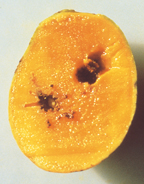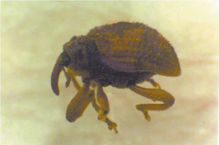(Sternochetus frigidus)

What to look for
Weevils in rotten mango pulp in seemingly unspoilt fruit.
What you can do
- Do not move plants, plant material or fruit out of the Torres Strait Protected Zone to the Torres Strait Permanent Biosecurity Monitoring Zone, or from either zone to mainland Australia without a permit and an inspection by a Department of Agriculture and Water Resources biosecurity officer.
- Notify the Department of Agriculture and Water Resources if you find weevils in mango pulp by phone on +61 7 4241 7800 or email NAQS.

Profile
Mango pulp weevils look similar to the mango seed weevil which is already found in some parts of Australia, but the pulp weevil attacks the flesh rather than the seed. There are no signs of the weevil on the outside of infested fruit. The weevils burrow into the pulp of the fruit to feed. The flesh rots and becomes inedible.

Larvae form distinctive brown chambers
Identification
It is hard to know if a mango is infested until you cut it open. Larvae can often be seen in the fruit’s flesh where they form distinctive brown chambers – you can see the small whitish grubs inside. They pupate within the fruit in a smaller chamber up to 1 cm in diameter. The adult weevil then exits the fruit, making a small hole in the skin.
Distribution
The weevil is present in Malaysia, the Philippines and parts of Indonesia.
Threat
If the pest becomes established in Australia, expensive control measures would be required. Domestic and export markets would be negatively affected, as well as backyard mangoes.

Close-up of weevil – size approximately 5 mm long
